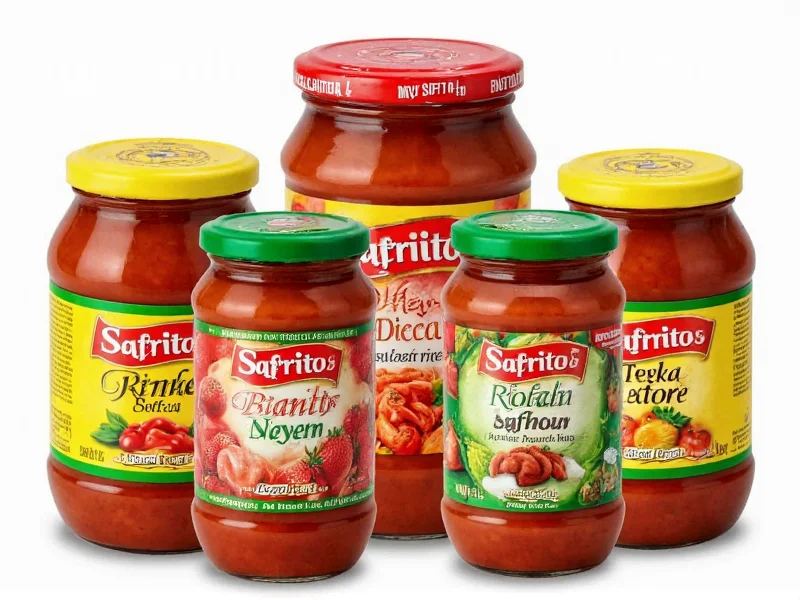Sofrito serves as the flavor foundation for countless Latin American and Caribbean dishes, from arroz con pollo to stews and bean preparations. While homemade sofrito remains the gold standard for many cooks, commercial brands provide convenient alternatives for those seeking consistent flavor without the preparation time. Understanding the differences between available brands helps home cooks select the right product for their culinary needs.
Understanding Sofrito and Its Cultural Significance
Sofrito isn't a single standardized recipe but rather a cooking technique and flavor base that varies across regions. In Puerto Rico, sofrito often includes recao (culantro) and ajíes dulces (sweet peppers), while Cuban sofrito might feature more garlic and less cilantro. Dominican sofrito typically contains tomato sauce, and Spanish sofrito (sofrito español) usually includes tomatoes and paprika. These regional differences explain why no single commercial brand perfectly replicates every household's traditional recipe.
Key Factors When Evaluating Sofrito Brands
When comparing commercial sofrito options, consider these essential factors that impact both flavor and usability:
- Ingredient quality - Look for brands using fresh, recognizable ingredients without artificial preservatives
- Regional authenticity - Certain brands specialize in specific cultural interpretations of sofrito
- Texture and consistency - Some brands offer smoother blends while others maintain visible vegetable pieces
- Shelf stability - Options range from refrigerated fresh-style to shelf-stable canned varieties
- Sodium content - Varies significantly between brands, important for health-conscious cooking
- Availability - Some regional brands may only be found in specialty markets
Comparison of Major Sofrito Brands
The following table compares the most accessible sofrito brands across key characteristics that matter to home cooks seeking authentic flavors:
| Brand | Key Ingredients | Regional Style | Package Size | Special Features |
|---|---|---|---|---|
| Goya Sofrito | Tomato, bell peppers, onion, garlic, cilantro, olive oil | Caribbean/Latin fusion | 8 oz glass jar, 6 oz can | Widely available, consistent flavor, no artificial preservatives |
| Badia Sofrito | Tomato, green peppers, onion, garlic, cilantro, olive oil | Cuban-influenced | 8 oz glass jar | Slightly thicker consistency, strong garlic presence |
| Grace Sofrito | Tomato, bell peppers, onion, garlic, thyme, pimento | Jamaican/Caribbean | 7.5 oz glass jar | Includes Caribbean spices, slightly sweeter profile |
| El Conquistador Sofrito | Tomato, bell peppers, onion, garlic, cilantro | Puerto Rican style | 8 oz glass jar | Features recao (culantro), closer to traditional Puerto Rican recipe |
| La Preferida Sofrito | Tomato, bell peppers, onion, garlic, cilantro, olive oil | General Latin | 8 oz glass jar, 15 oz can | Budget-friendly option, milder flavor profile |
Regional Sofrito Brand Specialties
While national brands dominate supermarket shelves, regional specialty brands offer more authentic interpretations for specific culinary traditions. For Puerto Rican cooking, brands like El Conquistador and Rican Vitamin provide sofrito with recao (culantro), which is essential to authentic Puerto Rican flavor profiles. Cuban cooks might prefer Badia or Cuban Goodies sofrito, which emphasize garlic and omit culantro. Dominican cooks often seek brands that include tomato sauce as a base component.
When selecting a sofrito brand for specific recipes, consider which cultural tradition you're following. The best sofrito brands for Puerto Rican cooking differ from those ideal for Cuban or Dominican dishes. Many specialty Latin markets carry regional brands that may not be available in mainstream grocery stores.
Using Commercial Sofrito Effectively
Commercial sofrito brands work best when treated as a flavor foundation rather than a complete seasoning solution. For optimal results:
- Always sauté commercial sofrito in oil for 3-5 minutes before adding other ingredients to develop flavors
- Supplement with fresh aromatics like additional garlic or culantro for more vibrant flavor
- Adjust salt levels since commercial brands vary in sodium content
- Consider adding a splash of wine or vinegar to brighten the flavor profile
- Use within 7-10 days after opening if refrigerated, or follow package instructions for shelf-stable varieties
For those comparing sofrito brands versus homemade versions, commercial options provide convenience but often lack the complexity of freshly prepared sofrito. Many cooks use a combination approach—starting with commercial sofrito as a base then enhancing with fresh ingredients.
Finding Quality Sofrito Brands
Where to buy authentic sofrito brands depends on your location and specific needs. Major supermarket chains typically carry Goya and occasionally Badia in the international foods section. Latin specialty markets offer the widest selection, including regional brands that cater to specific cultural traditions. Online retailers provide access to specialty sofrito brands regardless of geographic location, though shipping costs for refrigerated items can be prohibitive.
When searching for organic sofrito brand options, check health food stores or online specialty retailers, as mainstream organic options remain limited. Some artisanal producers offer small-batch sofrito through farmers' markets or online platforms, often with higher quality ingredients but at premium prices.











 浙公网安备
33010002000092号
浙公网安备
33010002000092号 浙B2-20120091-4
浙B2-20120091-4